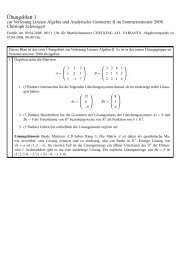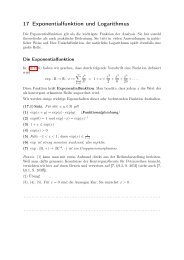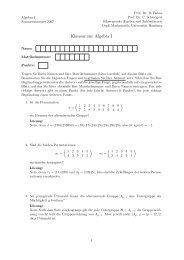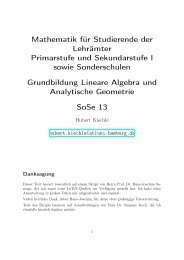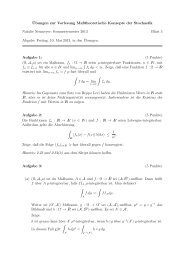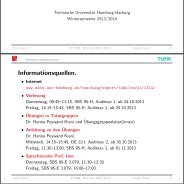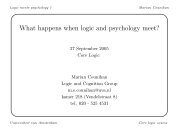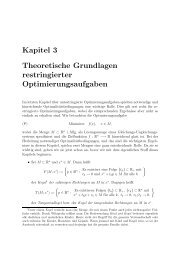pdf file
pdf file
pdf file
You also want an ePaper? Increase the reach of your titles
YUMPU automatically turns print PDFs into web optimized ePapers that Google loves.
Finally, apply ɛ to the equality<br />
ɛ(x)1 = S(x (1) ) ∙ x (2)<br />
to get<br />
ɛ(x) = ɛ(x)ɛ(1) = ɛ(S(x (1) )ɛ(x (2) ) = ɛ ◦ S(x) for all x ∈ H .<br />
✷<br />
Proposition 2.5.6.<br />
Let H be a Hopf algebra. Then the following identities are equivalent:<br />
(a) S 2 = id H<br />
(b) ∑ x S(x (2))x (1) = ɛ(x)1 H for all x ∈ H.<br />
(c) ∑ x x (2)S(x (1) ) = ɛ(x)1 H for all x ∈ H.<br />
Proof.<br />
We show (b) ⇒ (a) by first showing from (b) that S ∗ S 2 is the identity for the convolution<br />
product. In graphical notation, (b) reads<br />
S<br />
=<br />
Thus<br />
S<br />
S ∗ S 2 = S =<br />
S 2<br />
S<br />
=<br />
(b)<br />
S<br />
= = η ◦ ɛ<br />
For comparison, we also compute in equations:<br />
S ∗ S 2 (x) = ∑ ( ∑ )<br />
S(x (1) )S 2 (x (2) ) = S S(x (2) )x (1)<br />
(x)<br />
(x)<br />
(b)<br />
= S(ɛ(x)1) = ɛ(x)S(1) = ɛ(x)1 .<br />
Then conclude S 2 = id by the uniqueness of the inverse of S with respect to the convolution<br />
product.<br />
Conversely, assume S 2 = id H<br />
S<br />
S<br />
=<br />
S<br />
S<br />
S<br />
S 2 = id<br />
S S S S<br />
= = = = η ◦ ɛ<br />
where we used S 2 = id, the fact that S is an anticoalgebra map, again S 2 = id and then the<br />
defining property of the antipode S. The equivalence of (c) and (a) is proven in complete<br />
35






